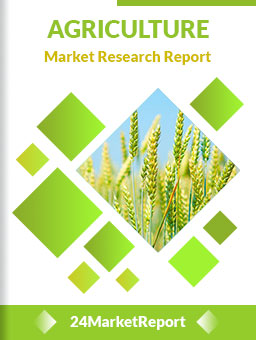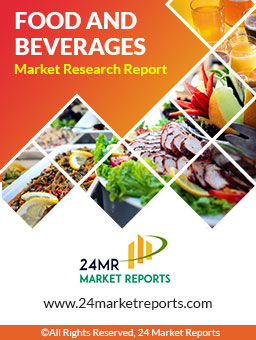
Download FREE Report Sample
Download Free sample
MARKET INSIGHTS
Global Luo Han Guo Extract market size was valued at USD 235 million in 2024 and is projected to grow from USD 293 million in 2025 to USD 1,064 million by 2032, exhibiting a CAGR of 24.7% during the forecast period.
Luo Han Guo Extract, derived from the monk fruit (Siraitia grosvenorii), is a natural sweetener containing bioactive compounds called mogrosides. Mogroside V serves as the primary sweetening component, delivering 230-260 times the sweetness of sucrose without calories. The extract also contains flavonoids, protein fragments, and secondary mogrosides (II, III, IV, and VI), making it a popular sugar alternative in health-focused food and beverage formulations.
The market's explosive growth stems from rising consumer demand for clean-label sweeteners and increasing diabetes prevalence worldwide. North America dominates consumption with 44% market share, while Asia-Pacific follows at 33%. Notably, high-purity extracts (>50% Mogroside-V) command 64% of the market, reflecting industry prioritization of product efficacy. Intense competition exists among manufacturers, with market leaders Monk Fruit Corp, Layn, and Hunan Huacheng Biotech collectively holding 80% revenue share through advanced extraction technologies and strategic partnerships.
Rising Consumer Preference for Natural Sweeteners to Fuel Market Growth
The global shift towards healthier lifestyles and clean-label products is accelerating demand for natural sweeteners like Luo Han Guo extract. With obesity rates surpassing 650 million adults worldwide and diabetes affecting over 537 million people, consumers are actively seeking sugar alternatives. Unlike artificial sweeteners facing scrutiny over health concerns, monk fruit extract offers a zero-calorie, naturally-derived solution with sweetness 200-300 times greater than sugar. Major food manufacturers are reformulating products to replace synthetic additives, with the natural sweetener market projected to grow at 6.5% CAGR through 2030.
Regulatory Approvals Expanding Application Potential
To know more about market statistics, Download a FREE Sample copy
Recent regulatory milestones have significantly expanded market opportunities. The FDA's GRAS (Generally Recognized As Safe) designation for Luo Han Guo extract has enabled its use across over 30 food categories in the U.S. Similarly, the European Food Safety Authority's 2023 safety evaluation has opened doors for broader EU market penetration. In functional foods and beverages - currently representing 42% of applications - the extract's antioxidant properties are gaining recognition. Pharmaceutical applications are emerging too, with clinical trials investigating mogrosides for anti-inflammatory and anti-diabetic effects.
Strategic Industry Collaborations Driving Innovation
The competitive landscape is evolving through vertical integration and technology partnerships. Leading producer Layn Corporation recently entered a joint venture worth $25 million to enhance extraction efficiency, targeting 98% purity levels for pharmaceutical-grade mogrosides. Similarly, Monk Fruit Corp's acquisition of agricultural lands in Guangxi (China's primary growing region) secured 40% of annual raw material supply. Such strategic moves ensure supply chain stability while enabling R&D investments in novel formulations like encapsulated sweeteners for heat-stable baking applications.
High Production Costs Limiting Market Penetration
Despite growing demand, Luo Han Guo extract faces pricing challenges in mainstream markets. The complex extraction process yields only 0.5-0.8% mogroside content from fresh fruit, requiring 8-10 tons of raw material per ton of 50% purity extract. This contributes to prices 15-20 times higher than conventional sweeteners. Smallholder farming predominates in China, where 60% of growers operate plots under 5 acres, limiting economies of scale. Transportation of perishable fruits from remote mountainous regions adds 18-22% to operational costs. These factors currently restrict adoption to premium product segments.
Supply Chain Vulnerabilities Impacting Market Stability
The concentrated geographic production creates significant supply risks. Guangxi province accounts for 83% of global Luo Han Guo cultivation, making the market susceptible to climate disruptions. The 2022 drought reduced yields by 30%, causing extract prices to spike 45% within six months. Pests like the melon fruit fly have required $12 million annually in containment measures. Furthermore, international trade complexities arise from China's extract export controls, which mandate 22 different certifications for overseas shipments. These bottlenecks challenge manufacturers seeking consistent supply for global distribution.
Emerging Blends with Complementary Sweeteners Creating New Markets
Innovative formulations combining Luo Han Guo with other natural sweeteners present lucrative growth avenues. Blends with allulose - which masks monk fruit's lingering aftertaste - are gaining traction, projected to capture 28% of the alternative sweetener market by 2027. Stevia-Luo Han Guo hybrid extracts now feature in 74 new product launches annually, particularly in protein shakes and nutrition bars. The synergy between these ingredients allows for 40-60% reduction in total sweetener content while improving flavor profiles. Such innovations address formulation challenges that previously limited adoption in mainstream products.
Functional Food Expansion into New Health Segments
Beyond sweetness, the extract's therapeutic potential is unlocking opportunities in nutraceuticals. Clinical studies indicate mogrosides may help reduce fasting blood glucose by 15-20%, driving interest from diabetes management brands. The antioxidant properties show promise in skincare too, with 23 major cosmetics companies now testing monk fruit derivatives as natural preservatives. Pediatric nutrition represents another frontier, where the extract's safety profile supports development of low-glycemic infant formulas. With functional food sales exceeding $275 billion globally, these applications could double Luo Han Guo's addressable market by 2030.
Intellectual Property Disputes Creating Market Uncertainty
The industry faces growing legal complexities around extraction technologies. Since 2020, 14 patent infringement lawsuits have been filed regarding mogroside purification methods, primarily between Chinese and U.S. manufacturers. This legal friction has delayed 7 commercial production facilities awaiting technology clearance. Furthermore, traditional cultivation knowledge held by Zhuang ethnic communities in China remains unprotected, raising concerns about equitable benefit sharing. Such IP challenges complicate investment decisions and may slow the pace of technological advancement in the sector.
Consumer Education Gaps Hindering Adoption
Despite regulatory approvals, awareness barriers persist in key markets. Surveys indicate 68% of European consumers cannot identify monk fruit as a sweetener, while 42% of U.S. shoppers mistakenly associate it with artificial ingredients. Flavor inconsistency issues also challenge adoption - extract bitterness varies by 3-5 intensity points between batches due to seasonal mogroside fluctuations. Manufacturers must invest $3-5 million annually in sensory testing and consumer education to overcome these hurdles. The lack of standardized labeling terms across regions further compounds confusion, with 12 different descriptive terms currently in use globally.
Above 50% Mogroside-V Segment Dominates Due to Higher Sweetness and Purity
The Luo Han Guo Extract market is segmented based on Mogroside-V content into:
30%-50% Mogroside-V
Above 50% Mogroside-V
Others
Food and Beverage Segment Leads With Increasing Demand for Natural Sweeteners
The major application segments include:
Food and Beverage
Subtypes: Dairy products, baked goods, beverages
Medicines and Health Products
Others
Powder Form Holds Significant Share Due to Ease of Use and Storage
Market segmentation by physical form includes:
Powder
Liquid
Crystals
Natural Sweetener Market Intensifies as Brands Compete for Health-Conscious Consumers
The Luo Han Guo extract market exhibits a concentrated competitive structure, with the top three players collectively controlling 80% of global revenue share in 2024. This high market concentration stems from the specialized extraction technologies and established supply chains required for producing high-purity monk fruit sweeteners. While the industry remains dominated by Chinese manufacturers due to the fruit's geographic origin, international brands are increasingly forming strategic partnerships to secure supply.
Monk Fruit Corp leads the market with superior extraction capabilities for mogrosides above 50% purity - the most commercially valuable segment. Their patented water extraction process yields extracts with 260 times the sweetness of sugar while maintaining clean label credentials, making them the preferred supplier for premium beverage formulations in North America.
Layn Natural Ingredients and Hunan Huacheng Biotech complete the market's triumvirate through differentiated strategies. Layn has successfully positioned itself as the extraction partner of choice for multinational CPG brands, while Huacheng Biotech dominates domestic Chinese distribution channels for both food and pharmaceutical applications.
Second-tier players including GLG Life Tech and Guilin Saraya Biotech are gaining traction through technological innovations in enzymatic extraction methods. These advancements have improved yield efficiency by 15-20% compared to traditional processes, enabling competitive pricing while maintaining the thermal stability of mogrosides - a critical factor for baked good applications.
Monk Fruit Corp (China)
Layn Natural Ingredients (China)
Hunan Huacheng Biotech (China)
GLG Life Tech (Canada)
Guilin Sanleng Biotech (China)
Guilin Saraya Biotech (China)
Hunan Nutramax (China)
The global Luo Han Guo extract market is experiencing significant growth due to increasing consumer preference for natural, low-calorie sweeteners. With growing awareness about health risks associated with artificial sweeteners and refined sugars, demand for monk fruit extract has surged by approximately 18-22% annually since 2020. Food and beverage manufacturers are reformulating products to include Luo Han Guo extract as a natural alternative, particularly in North America where 44% of global consumption occurs. The extract's unique property of being 230-260 times sweeter than sucrose while contributing negligible calories makes it particularly attractive to health-conscious consumers and diabetic populations.
Premiumization of High-Purity Extracts
There's a notable shift toward higher purity Luo Han Guo extracts, with products containing above 50% Mogroside-V now dominating 64% of market share. This premium segment commands significantly higher prices due to both its superior sweetness profile and emerging research suggesting potential health benefits beyond sweetening. Food manufacturers are willing to pay premiums for these highly concentrated extracts because they require smaller quantities to achieve desired sweetness levels, improving formulation economics despite higher per-unit costs.
Extraction technology innovations are dramatically improving yields and purity levels while reducing production costs. Advanced techniques including enzymatic extraction and membrane separation have increased mogroside yields by 30-35% compared to traditional methods. These improvements are critical as the market scales to meet rapidly growing demand while maintaining profitability. Several leading manufacturers have recently invested in continuous extraction systems that reduce processing time by 40% and solvent use by 25%, addressing both economic and environmental concerns in production.
North America
North America dominates the Luo Han Guo Extract market with a 44% consumption share, driven by rising health consciousness and demand for natural sweeteners. The U.S. leads due to stringent FDA regulations favoring zero-calorie sweeteners and growing diabetic populations. Major food & beverage manufacturers are increasingly reformulating products with monk fruit extract to meet clean-label trends. However, high production costs and limited domestic cultivation create reliance on imports, primarily from China. The region shows strong potential for high-purity extracts (>50% Mogroside-V) in premium health supplements and functional foods.
Europe
Europe represents a steadily growing market, with demand fueled by EU sugar reduction initiatives and strict food additive regulations under EFSA. Countries like Germany and the UK show particular interest in organic-certified Luo Han Guo extracts for use in premium beverages and confectionery. The region faces supply chain challenges due to dependence on Asian producers, although local distributors are expanding partnerships with Chinese manufacturers. Trade policies and Brexit-related import complexities slightly hinder market fluidity, but long-term growth persists due to sustained demand for plant-based sweeteners.
Asia-Pacific
As the native region of Luo Han Guo, Asia-Pacific holds 33% market share with China as both the primary producer and consumer. Domestic brands like Hunan Huacheng Biotech leverage localized cultivation advantages, while export-oriented processing zones cater to global demand. Japan and South Korea exhibit growing adoption in functional foods, driven by aging populations seeking glycemic control solutions. However, price sensitivity in developing markets leads to preference for mid-range purity extracts (30-50% Mogroside-V). The region benefits from integrated supply chains but faces quality inconsistency issues among smaller producers.
South America
The South American market remains nascent but shows promise with Brazil and Argentina exhibiting gradual uptake in health-focused product formulations. Economic instability limits widespread adoption, though the rising middle class demonstrates willingness to pay premium prices for natural sweeteners in select urban markets. Regulatory frameworks lack specificity around novel sweeteners, creating uncertainty for importers. Strategic partnerships between local distributors and Chinese suppliers are emerging to improve market penetration, particularly for use in herbal supplements and reduced-sugar beverages.
Middle East & Africa
This region presents long-term growth opportunities with increasing diabetes prevalence in Gulf Cooperation Council (GCC) countries driving demand for sugar alternatives. The UAE and Saudi Arabia lead in adoption due to expatriate demographics and premium health food trends, although market education remains necessary to compete with established sweeteners like stevia. Africa's development potential is hampered by limited infrastructure and price sensitivity, though urban centers in South Africa and Nigeria show gradual interest in imported natural health products containing monk fruit extract.
This market research report offers a holistic overview of global and regional markets for the forecast period 2025–2032. It presents accurate and actionable insights based on a blend of primary and secondary research.
✅ Market Overview
Global and regional market size (historical & forecast)
Growth trends and value/volume projections
✅ Segmentation Analysis
By product type or category
By application or usage area
By end-user industry
By distribution channel (if applicable)
✅ Regional Insights
North America, Europe, Asia-Pacific, Latin America, Middle East & Africa
Country-level data for key markets
✅ Competitive Landscape
Company profiles and market share analysis
Key strategies: M&A, partnerships, expansions
Product portfolio and pricing strategies
✅ Technology & Innovation
Emerging technologies and R&D trends
Automation, digitalization, sustainability initiatives
Impact of AI, IoT, or other disruptors (where applicable)
✅ Market Dynamics
Key drivers supporting market growth
Restraints and potential risk factors
Supply chain trends and challenges
✅ Opportunities & Recommendations
High-growth segments
Investment hotspots
Strategic suggestions for stakeholders
✅ Stakeholder Insights
Target audience includes manufacturers, suppliers, distributors, investors, regulators, and policymakers
-> Key players include Monk Fruit Corp, Layn, Hunan Huacheng Biotech, GLG Life Tech, Guilin Sanleng Biotech, Guilin Saraya Biotech, and Hunan Nutramax, with the top three manufacturers holding 80% market share.
-> Key growth drivers include rising demand for natural sweeteners, increasing health consciousness, and expanding applications in food & beverage and healthcare sectors.
-> North America is the largest market with 44% share, followed by Asia-Pacific at 33%, driven by strong demand in China and the US.
-> Emerging trends include advancements in extraction technologies, increasing R&D for high-purity mogrosides, and expansion into pharmaceutical applications.

Speak to our Custom Research Team and get the Custom Research in a budget
Custom ResearchFrequently Asked Questions ?
A license granted to one user. Rules or conditions might be applied for e.g. the use of electric files (PDFs) or printings, depending on product.
A license granted to multiple users.
A license granted to a single business site/establishment.
A license granted to all employees within organisation access to the product.
Upto Working 24 to 48 hrs
Upto 72 hrs max - Weekends and Public Holidays
Online Payments with PayPal and CCavenue
Wire Transfer/Bank Transfer
Hard Copy




 Industry Market Size
Industry Market Size SWOT Analysis
SWOT Analysis Industry Major Players
Industry Major Players Revenue Forecasts
Revenue Forecasts Historical and Forecast Growth
Historical and Forecast Growth Profitability Analysis
Profitability Analysis
























